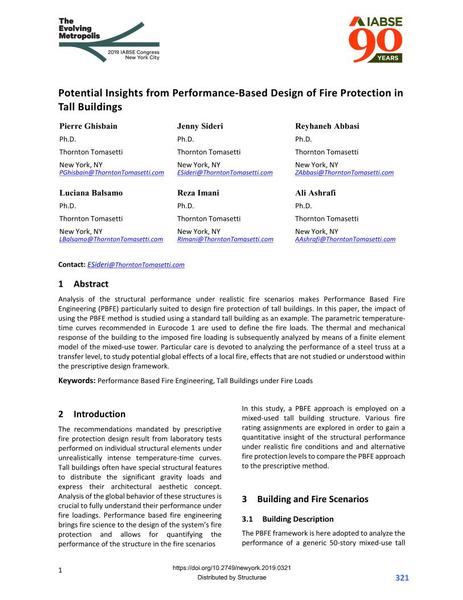Potential Insights from Performance-Based Design of Fire Protection in Tall Buildings

|
|
|||||||||||
Bibliographic Details
| Author(s): |
Pierre Ghisbain
(Thornton Tomasetti)
Jenny Sideri (Thornton Tomasetti) Reyhaneh Abbasi (Thornton Tomasetti) Luciana Balsamo (Thornton Tomasetti) Reza Imani (Thornton Tomasetti) Ali Ashrafi (Thornton Tomasetti) |
||||
|---|---|---|---|---|---|
| Medium: | conference paper | ||||
| Language(s): | English | ||||
| Conference: | IABSE Congress: The Evolving Metropolis, New York, NY, USA, 4-6 September 2019 | ||||
| Published in: | The Evolving Metropolis | ||||
|
|||||
| Page(s): | 321-327 | ||||
| Total no. of pages: | 7 | ||||
| DOI: | 10.2749/newyork.2019.0321 | ||||
| Abstract: |
Analysis of the structural performance under realistic fire scenarios makes Performance Based Fire Engineering (PBFE) particularly suited to design fire protection of tall buildings. In this paper, the impact of using the PBFE method is studied using a standard tall building as an example. The parametric temperature- time curves recommended in Eurocode 1 are used to define the fire loads. The thermal and mechanical response of the building to the imposed fire loading is subsequently analyzed by means of a finite element model of the mixed-use tower. Particular care is devoted to analyzing the performance of a steel truss at a transfer level, to study potential global effects of a local fire, effects that are not studied or understood within the prescriptive design framework. |
||||
| Keywords: |
performance-based fire engineering Tall Buildings under Fire Loads
|
||||
